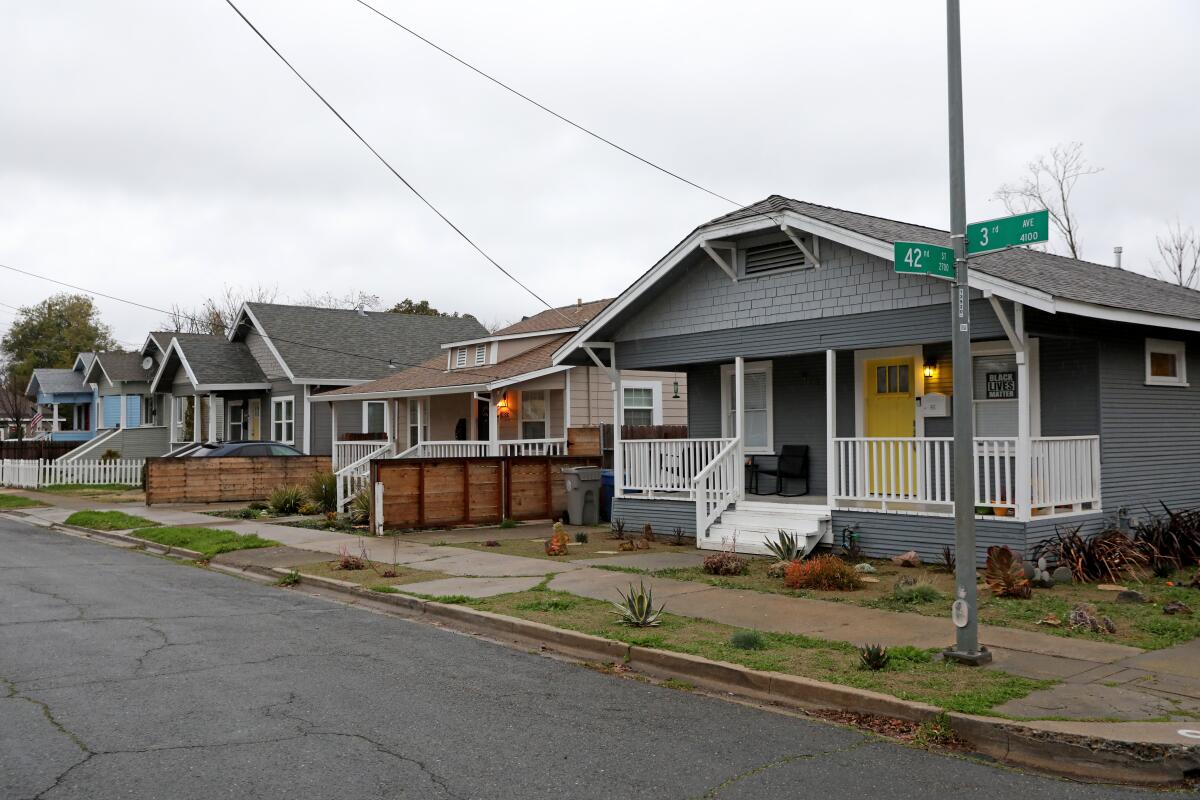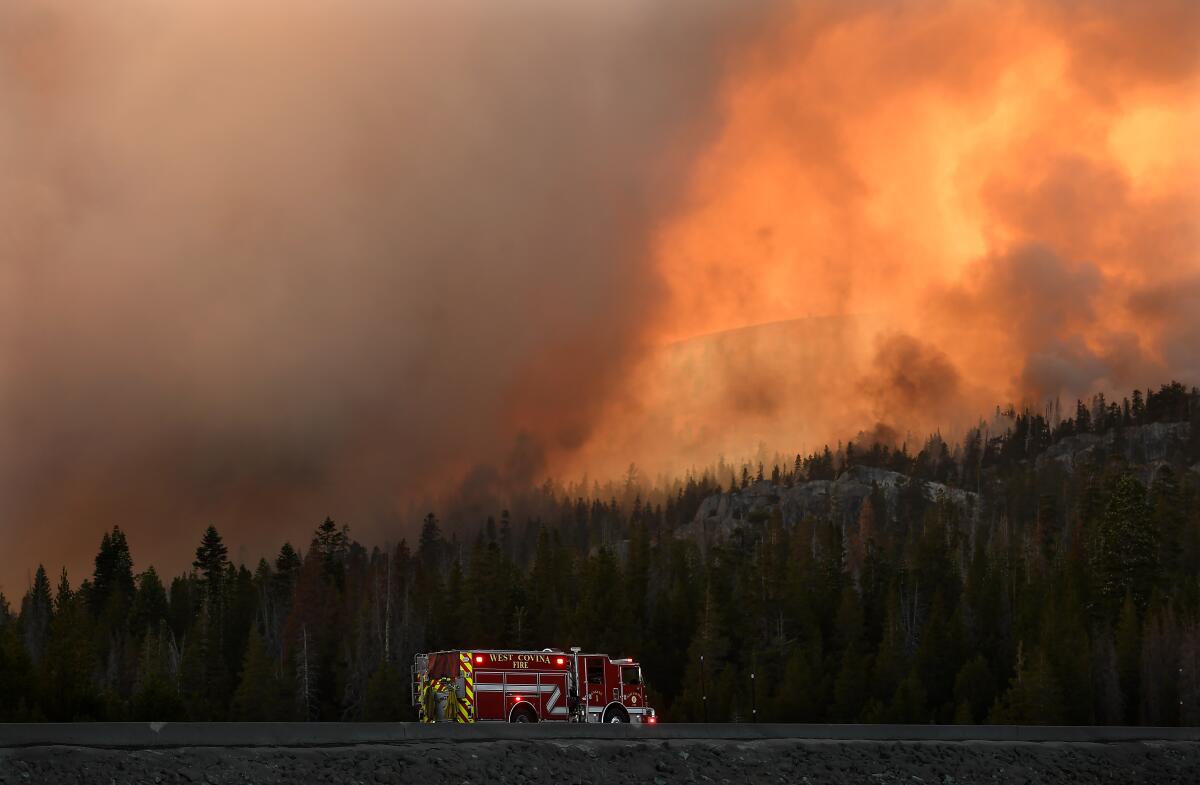The big change coming to California neighborhoods

- Share via
Hi and welcome to the Essential California newsletter. It’s Friday, Sept. 3. I’m Liam Dillon. I write about housing affordability and neighborhood change for The Times, and I’m your newsletter guest host for the day.
I’m going to tell you about a big change that’s on the verge of happening in California.
For the record:
5:17 p.m. Sept. 4, 2021This article has been corrected to reflect the origin of the city of Berkeley’s single-family-home zoning laws. While motivated by racist intent, the laws were not a reaction to a U.S. Supreme Court ruling that banned racial zoning. Berkeley’s zoning laws went into effect in 1916 and the Supreme Court ruling occurred a year later.
Earlier this week, the state Legislature gave final approval to a bill that would end single-family-only zoning. This sounds technical but here’s the upshot: With few exceptions, every residential community in California would have to allow a minimum of two homes, or duplexes, on a lot and in some cases as many as four homes.
In some ways, it’s tough to overestimate how much of a shift this would be.
Nearly two-thirds of all the residences in California are single-family homes. And as much as three-quarters of the developable land in the state is now zoned only for single-family housing, according to UC Berkeley research.
Just as significantly, single-family housing is very much part of the mythos of Southern California.
“The life of suburbia attracted so many Americans from all over the country to come to sunny California,” said Los Angeles City Councilman Kevin de León. “Especially when the Rose Bowl was being played during the winter months. On the East Coast and the Midwest, folks would say, ‘Wow, orange trees, lemon trees, frontyard, backyard, a swimming pool, a single-family home. Let’s pack it up, let’s leave Michigan, let’s leave Ohio and let’s go out to the West Coast.’”
But those behind the change contend that single-family-only zoning is a relic of a past that is no longer justifiable. It originated in the city of Berkeley a century ago as a segregationist practice to prevent a Black-owned dance hall from locating near a white-only subdivision.
Supporters of ending single-family-only zoning also argue that in a state with such a deep affordability crisis opening up neighborhoods to more development will allow less expensive housing to be built there.
The median sales price in California for a single-family home was $811,000 in July, according to the California Assn. of Realtors.
Someone who thinks what the California Legislature is doing is a good idea is President Biden. As my colleague Erin B. Logan reported earlier this week, the Biden administration praised California’s potential end of single-family-only zoning as a way to promote broader affordability in the state.
In other ways, though, the practical changes inaugurated by the new zoning legislation won’t be as profound as they may seem.
Property owners will still be allowed to build single-family homes on their land if they want to. It’s just that cities will no longer be able to prevent people from building duplexes.
Additionally, other zoning changes in recent years have already made it a lot easier for property owners to build smaller secondary homes — known as granny flats, casitas or accessory dwelling units — on their single-family-home-zoned parcels. Indeed, UC Berkeley researchers recently found that it would make financial sense for property owners of only about 5% of the state’s 7.5 million single-family lots to add more homes on their property.
The fate of this zoning change now rests with Gov. Gavin Newsom. He hasn’t committed to signing the bill, but has made positive statements about it. Should Newsom sign it by the mid-October deadline, the change would take effect Jan. 1.
We spent a lot of time talking about the history of single-family-only zoning in California and its pros and cons on the latest episode of “Gimme Shelter,” the biweekly podcast on the state’s affordability issues I co-host with Manuela Tobias, a housing reporter with Sacramento-based news nonprofit CalMatters. This is also a plug that if you care about housing affordability in the state, please sign up to listen to the podcast because we go deep on these issues every two weeks.
And now, here’s what’s happening across California.
Note: Some of the sites we link to may limit the number of stories you can access without subscribing.
The Caldor fire near Lake Tahoe has eclipsed 200,000 acres as President Biden declared an emergency that will allow more federal assistance to flow to the region. Dry conditions and low humidity are persistent problems, and officials warned the situation remained very dangerous. By Thursday afternoon, the fire had scorched more than 210,000 acres, destroyed more than 800 structures and was 25% contained. Though tens of thousands of people had been forced from their homes, firefighters have mostly been able to keep the blaze away from major resort areas. Los Angeles Times

)
L.A. STORIES
The Museum of Contemporary Art named Johanna Burton its new executive director on Thursday. Burton is coming to L.A. from the Wexner Center for the Arts at the Ohio State University. The museum, however, attempted to highly stage manage the announcement beforehand, and our art critic Christopher Knight wasn’t having it. “The paranoia level around its newest hire is at Code Red,” Knight writes. “The once-proud museum has limped through a dozen years of serious staffing adversities in both the administrative and curatorial ranks, and this appointment is make-or-break news. They’ve got to get this right.” MOCA | Los Angeles Times
A makeshift backyard fight club in South Los Angeles became a popular destination for fight fans and local boxers and mixed-martial artists during the COVID-19 pandemic. But out of safety concerns, the California State Athletic Commission shut it down. Organizers are looking to fundraise to bring the fighting back. New York Times
'The Times' podcast
Our new weekday podcast, hosted by columnist Gustavo Arellano, takes listeners beyond the headlines. Subscribe on Apple Podcasts and follow on Spotify.
THE WAR IN AFGHANISTAN
Four of the 13 U.S. troops who died following a suicide bombing at the Kabul international airport in Afghanistan last week were from California. We profiled Cpl. Kareem Nikoui, Sgt. Nicole Gee, Lance Cpl. Dylan Merola and Cpl. Hunter Lopez. Los Angeles Times
CRIME AND COURTS
My colleague Leila Miller tells a tale from Santa Barbara about an unspeakable tragedy. A 40-year-old husband drove his 2-year-old son and 10-month-old daughter to Mexico where he killed them with a spearfishing gun, U.S. authorities say. Authorities and community members are trying to piece together how Matt Coleman, a surfer who was involved in many Christian church groups, committed the act. Coleman told authorities that he had been influenced by QAnon, a sprawling conspiracy-fueled movement that has attracted primarily right-wing adherents with its claims that Satan-worshipping pedophiles control the country and have plotted against former President Trump. Los Angeles Times
Community organizations in Oakland are crying foul over a city policy that requires large fees to be paid for Police Department security at hosted events. Multiple groups, including a pro-cannabis organization and an art walk, had to cancel their planned events because they would have owed thousands of dollars in fees. Dozens of events presenters are asking the city to change the rules. KQED
Support our journalism
HEALTH AND THE ENVIRONMENT
Los Angeles County officials agreed to pay $400,000 to settle claims involving Grace Community Church in Sun Valley, which had repeatedly violated the county’s prohibitions against indoor services during the COVID-19 pandemic. The strength of the county’s legal argument against the church deteriorated after recent U.S. Supreme Court rulings that restricted public health measures against houses of worship. Los Angeles Times
Many restaurants, businesses and cultural institutions in Los Angeles are now requiring proof of vaccination against COVID-19. Our Utility Journalism team explains how to get a copy of your vaccine record and what to expect when you get to where you’re going. Los Angeles Times
Almost all teachers and staff in the San Francisco Unified School District have reported being fully vaccinated against COVID-19, the district said Thursday. In a district survey of its nearly 10,000 employees, 96% of those who responded said they were fully vaccinated. The district has said that all teachers and staff have to be vaccinated by Tuesday or face weekly testing. San Francisco Chronicle
Free online games
Get our free daily crossword puzzle, sudoku, word search and arcade games in our new game center at latimes.com/games.
CALIFORNIA ALMANAC
Los Angeles: A little toasty but cooler than it’ll be over the long weekend, 84. San Diego: Some clouds, and a little humid, 78. San Francisco: Partly cloudy and mild (but what else is new?), 66. San Jose: Sunny all day, 83. Fresno: Hot but still 10 degrees cooler than it’s supposed to be on Labor Day, 95. Sacramento: Sunny but not as hot as it could be, 90.
AND FINALLY
Today’s California memory is from Walt Barr:
In 1970 after graduating from college, I accepted a job in San Diego with the California Department of Transportation. I drove to San Diego — pulling a trailer — from Sacramento. My vehicle overheated on the Grapevine and then while in L.A. I got caught in an offramp-only lane. No one let me in. The lesson is to turn your signal on and just start moving over.
If you have a memory or story about the Golden State, share it with us. (Please keep your story to 100 words.)
Please let us know what we can do to make this newsletter more useful to you. Send comments to [email protected].
Sign up for Essential California
The most important California stories and recommendations in your inbox every morning.
You may occasionally receive promotional content from the Los Angeles Times.




